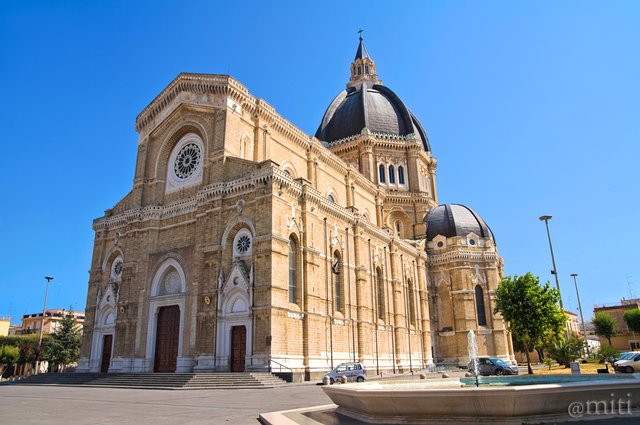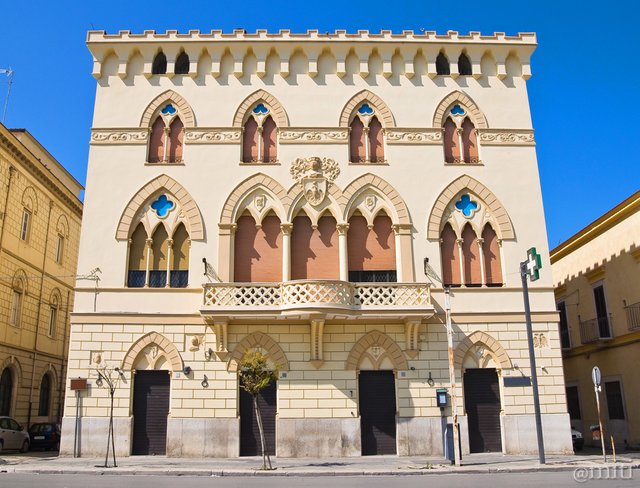A Journey through Italy: one photo every day #64 - CERIGNOLA [ENG/ITA]

The Tonti Cathedral (Author's photo - All rights reserved)
Il Duomo Tonti (Immagine dell'autore - tutti i diritti sono riservati)



Ciao a tutti,
questo è un viaggio attraverso l'Italia. Posterò una foto al giorno con una brevissima descrizione. Spero vi piaccia!

Cerignola è una città della provincia di Foggia, nella regione italiana meridionale della Puglia. Si trova su un'altura che segna il limite meridionale del Tavoliere delle Puglie.
Cerignola occupa il sito di Furfane, una stazione sull'antica via romana Traiana tra Canusium e Herdoniae. Apparentemente ha le sue radici nel X-XI secolo, cioè quando fu menzionato per la prima volta in un documento e quando iniziarono i lavori sull'antica cattedrale nel quartiere medievale (conosciuto come quartiere Terra vecchia).
Era un "municipium" durante l'Impero Romano. Nel Medioevo, come parte del Regno di Napoli, nel 1418 divenne feudo della famiglia Caracciolo.
Un piccolo insediamento, abitato da poche centinaia di famiglie, che il 28 aprile 1503 vide una battaglia campale tra francesi e spagnoli, che alcuni storici considerano uno dei momenti chiave della storia. La battaglia portò gli spagnoli ad occupare l'Italia meridionale per i successivi tre secoli.
Nella parte nord-occidentale della città si trova il quartiere medievale: costruito su un piano quasi circolare, con i suoi stretti vicoli tortuosi (e senza marciapiede), piccole piazze, cantine conosciute come "iusi", abitazioni al piano terra e case con vignale (scale esterne costruite parallelamente alla facciata), così come alcune residenze nobiliari del XVI-XVII secolo.
"Terra Vecchia" ospita anche la Chiesa Madre, risalente al X-XI secolo, le chiese di San Leonardo (XIV secolo) e Sant'Agostino (XVI secolo). Rientrando all'interno della città, troviamo le chiese cinquecentesche del Purgatorio e del Carmine, il settecentesco Palazzo Coccia in stile tardo barocco di Luigi Vanvitelli e l'imponente Duomo Tonti o Cattedrale Tonti (1855-1933) finanziato da un benefattore privato.
Appena fuori città, a nord-est, si trova la chiesa campestre trecentesca di Santa Maria delle Grazie, che conserva affreschi originali e un graffito che ricorda la Battaglia di Cerignola del 1503.
Cosa vedere: il centro storico, il Duomo Tonti, la Chiesa Madre, la Chiesa di San Leonardo, la Chiesa di Sant'Agostino, la Chiesa del Purgatorio, la Chiesa del Carmine, Palazzo Coccia, Palazzo Manfredi, la Chiesa di Santa Maria delle Grazie, il Palazzo Cirillo-Farrusi, il Piano delle Fosse del Grano.

Hello everyone,
I began a Photo Journey through Italy. I will post one photo every day with a little note of explanation. I hope you like it!

Cerignola is big town in the province of Foggia, in the Southern Italian region of Puglia. It lies on high ground marking the southern limit of the Puglia Tableland.
Cerignola occupies the site of Furfane, a station on the ancient Roman Via Traiana between Canusium and Herdoniae. It apparently has its roots back in the 10th-11th century that is when it was first mentioned in a document and when work began on the ancient cathedral in the medieval quarter (known as the Terra vecchia, or “Old Land”).
It was a municipium during the Roman Empire. In the Middle Ages, as part of the Kingdom of Naples, in 1418 it become a fief of the Caracciolo family.
A small settlement, inhabited by a few hundred families, which on 28th April 1503 saw a pitched battle between the French and the Spanish, which some historians regard as a key moment in history. The battle led to the Spanish occupying southern Italy for the next three centuries.
In the north-western part of the city lies the medieval quarter: built on an almost circular plan, with its narrow winding (and sidewalkless) alleyways, little squares, cellars known as iusi, ground-floor dwellings and houses with vignale (external staircases built parallel to the façade), as well as a few 16th-17th century nobleman’s residences.
“Terra Vecchia” also holds the Mother Church, or Chiesa Madre (10th-11th century), and the churches of San Leonardo (14th century), and Sant’Agostino (16th century). Back within the city itself, we find the 16th century churches of Purgatorio and Carmine, the 18th century Palazzo Coccia in the late Baroque style of Luigi Vanvitelli, and the imposing Tonti Cathedral or Duomo Tonti (1855-1933) funded by a private benefactor.
Just outside the city, to the north-east, is the 14th-century country church of Santa Maria delle Grazie, which contains original frescoes and a graffito commemorating the Battle of Cerignola in 1503.
Thing to see: the historic center, The Tonti Cathedral, the Mother Church, the Church of San Leonardo, the Church of Sant’Agostino, the Church of Purgatorio, the Church of Carmine, Coccia Palace, Manfredi Palace, the Church of Santa Maria delle Grazie, Cirillo-Farrusi Palace, the Piano delle Fosse del Grano.

| Tipo di foto / Category | Paesaggio / Landscape view |
| Esposizione / Settings | 1/200 sec, ISO 250, f/10 |
| Camera | Nikon D5000 |
| Lente / Lens | Tamron SP 17-50mm f/2.8 XR Di II LD |
| Filtro / Filter | Polarizzatore Hoya / Hoya Polarizing filter |
| Cavalletto / Tripod | Manfrotto MKC3-P01 |
| Località / Location | Cerignola (Foggia), Italia |
| Software | Photoshop |


Manfredi Palace (Author's photo - All rights reserved)
Palazzo Manfredi (Immagine dell'autore - tutti i diritti sono riservati)
Another historic place in Italy coming up with your photo journey. For the stemians it’s a great opportunity to visualize Italy even not going there. Thanks for sharing.
Thank you for those kind words!
sunshine!
Ancora in Puglia ed ancora in uno dei pochi luoghi che ho visitato nella mia carriera arbitrale.
Dopo Nardò è finalmente il turno di Cerignola: ricordo perfettamente questa cittadina ed in particolar modo il Duomo di Tonti con la sua splendida cupola.
Si, il duomo è davvero imponente ed è incredibile sia stato eretto per volere di un privato cittadino.
Must see place in Italy
Yes, absolutely!
Saluti amico miti, ha molte chiese in questa città. Deve essere molto bello perché le 2 foto sono belle, sono molto eleganti e belle l'architettura.
Si, ci sono in effetti tantissime chiese, alcune anche fuori dal centro abitato (chiesette rupestri).
Italy is my love. I was not in this city, a very beautiful cathedral. Thank you for your post! )
You're welcome!
Get $100 in Bitcoin and Get $10 Extra Free Here ! >>> http://bit.ly/2J4t1ZV